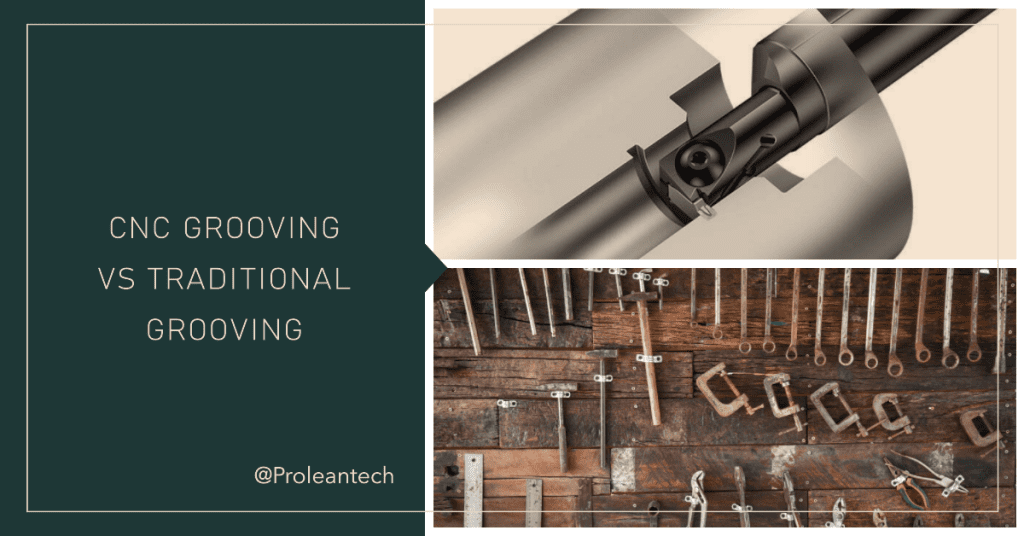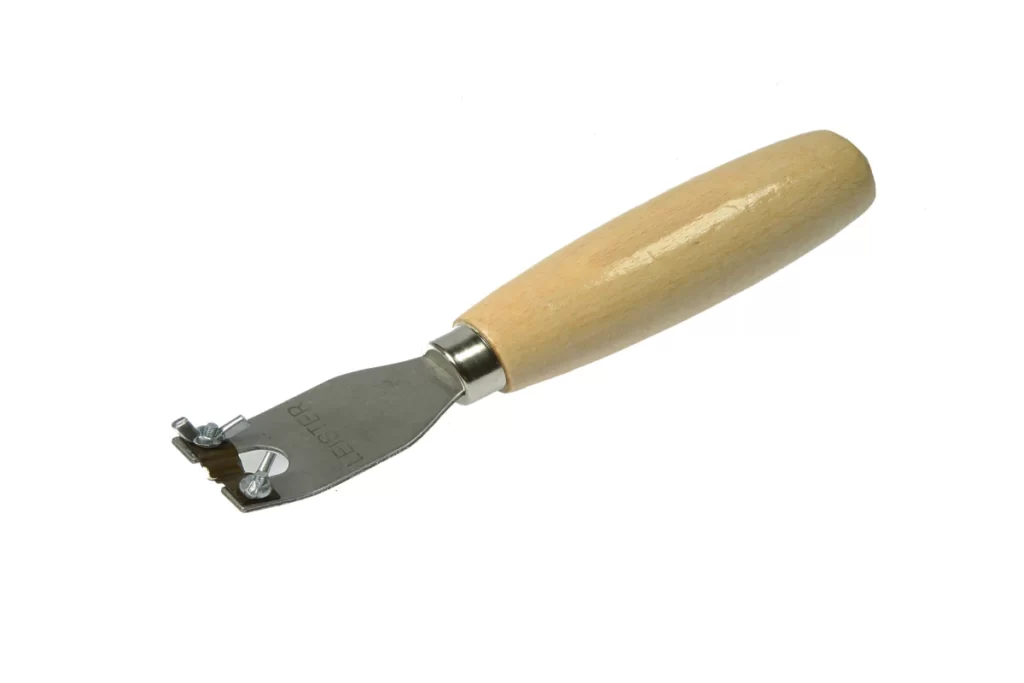Grooving operation is a machining process that involves cutting channels or slots into a workpiece material, typically metal, plastic, or wood. This process is essential in various industries, as it allows for the creation of joints, vents, and other functional features in a wide range of products. Grooving can be done using either traditional or CNC (Computer Numerical Control) methods, and each approach has its own set of benefits and drawbacks.

This article will explore the differences between CNC grooving and traditional grooving, discussing the advantages of each technique and providing guidance on how to choose the right method for your needs.
Traditional Grooving Process and Tools
The traditional grooving process involves the use of hand-operated or manually-controlled machines that rely on the skill and experience of the operator. These machines typically employ a single-point cutting tool, such as a parting tool, to remove material from the workpiece. To achieve the desired groove dimensions and surface quality, the operator must carefully control the tool’s depth, feed rate, and cutting speed.

Hand Grooving Tool
Traditional grooving tools are made from materials like high-speed steel (HSS) or carbide, and they come in various shapes and sizes to suit different applications. Some common types of traditional grooving tools include parting blades, grooving inserts, and form tools. These tools require regular sharpening and maintenance to ensure optimal performance and long service life.
CNC Grooving Machining
CNC grooving machining is a more modern approach to grooving that involves the use of computer-controlled machines to automate the cutting process. These machines can execute a wide range of tasks with high precision and repeatability, making them ideal for producing complex and intricate grooves in various materials. CNC grooving machines utilize advanced software to control the cutting tool’s movement, allowing for the creation of highly precise and consistent grooves.
CNC grooving machining has become increasingly popular in recent years, thanks to its numerous advantages over traditional methods. It offers greater accuracy, faster production speeds, and reduced waste, making it an attractive option for many manufacturers and engineers.
Read More: Types of Grooving Operations
CNC Grooving Process and Tools
The CNC grooving process begins with the creation of a digital model or blueprint of the desired groove, using specialized CAD (Computer-Aided Design) software. This model is then converted into a set of machine-readable instructions, known as G-code, which dictates the cutting tool’s movement and other variables such as feed rate and spindle speed.
Once the G-code is generated, it is loaded into the CNC grooving machine, which then executes the cutting process according to the specified parameters. CNC grooving tools, like their traditional counterparts, come in various shapes and sizes and are typically made from high-speed steel or carbide. However, CNC grooving tools often feature more advanced geometries and coatings to optimize their performance in demanding applications.
Comparing CNC Grooving vs Traditional Grooving Process with Various Criteria
When evaluating the merits of CNC grooving versus traditional grooving, several factors must be considered. These include:
- Accuracy: CNC grooving machines offer superior accuracy and repeatability compared to traditional methods. This means that CNC grooving can achieve tighter tolerances and more consistent results, especially when producing complex or intricate grooves.
- Speed: CNC grooving machines can complete grooving tasks much faster than traditional methods, thanks to their automated nature and advanced cutting tools. This can lead to significant time savings and increased productivity.
- Waste: CNC grooving machines typically produce less waste than traditional methods, as they can remove material more efficiently and precisely. This can result in reduced material costs and improved sustainability.
- Flexibility: CNC machines offer much greater flexibility compared to traditional methods. Thanks to their computer-controlled operation, they can easily be programmed to create a wide variety of groove types and sizes. This allows for more diverse and complex applications and makes it easier to accommodate custom orders or design changes.
- Safety: With CNC grooving, there is less risk of operator error, which can lead to injuries in traditional grooving processes. The operator doesn’t need to be as close to the cutting tool in CNC grooving, which can further increase safety.
- Cost: While the initial investment in CNC grooving equipment may be higher than traditional methods, the long-term costs can be lower. This is due to several factors, including the lower waste, faster speed, and reduced need for manual labor associated with CNC grooving.
- Skill requirement: Traditional grooving methods require highly skilled operators who can manually control the grooving process. In contrast, CNC grooving requires programming skills to set up the machine, but once the program is running, the machine takes over.
- Maintenance: CNC machines often have self-diagnostic abilities, enabling easy troubleshooting and reducing downtime. Traditional grooving tools, on the other hand, may require more frequent maintenance and adjustments.
Table 2: Comparison of CNC Grooving vs Traditional Grooving Process
| Criteria | CNC Grooving | Traditional Grooving |
|---|---|---|
| Accuracy | High | Lower |
| Speed | Fast | Slower |
| Waste | Less | More |
| Flexibility | High | Lower |
| Safety | Higher | Lower |
| Cost | Lower long-term costs | Potential higher long-term costs |
| Skill Requirement | Programming skills | Manual operation skills |
| Maintenance | Less frequent with self-diagnostic abilities | More frequent and potentially more complex |
Deciding Between Traditional and CNC Grooving
Choosing the right grooving method involves considering several factors, including project requirements, costs, time, and available resources. In this section, we will delve into these considerations to help you decide between traditional and CNC grooving.
1. Understand Your Project Requirements
Your project’s specific requirements are one of the first things you should consider. Evaluate these aspects:
- Design Complexity: For complex designs with intricate patterns, CNC grooving tends to be a more feasible option due to its high precision and accuracy.
- Tolerance Levels: If your project requires tight tolerances, CNC grooving is the preferred method, as it provides consistent and highly accurate results.
- Batch Size: For small quantities or one-off projects, traditional grooving can be cost-effective. However, for larger volumes, the speed and efficiency of CNC grooving make it the better choice.
2. Evaluate Your Time Constraints & Costs
Time is a critical factor in any project.
- Project Deadline: CNC grooving provides faster operation and can be a lifesaver for projects with tight deadlines.
- Lead Time: For projects with flexible deadlines, the lower upfront costs of traditional grooving may make it a viable choice.
- Upfront Investment: Traditional grooving requires a smaller upfront investment. On the other hand, while CNC grooving machines require a higher initial investment, they offer lower long-term costs due to factors like less waste, faster speed, and reduced labor needs.
- Operating Costs: CNC machines often come with lower operating costs, as they are more efficient, require less manual labor, and can reduce waste.
3. Assess Available Skills and Resources
The skills and resources available at your disposal also influence your decision.
- Skill Level of Staff: Traditional grooving requires skilled operators. If your team doesn’t have the necessary skills, training costs and time need to be considered. CNC grooving requires programming skills, but once the program is set up, the machine does the rest.
- Existing Infrastructure: If you already have CNC machines, implementing CNC grooving could be a straightforward decision. If not, you need to consider the investment required to set up this infrastructure.
Table 3: Choosing between CNC and Traditional Grooving
| Factor | CNC Grooving | Traditional Grooving |
|---|---|---|
| Design Complexity | Better for complex designs | Better for simple designs |
| Tolerance Levels | High precision | Lower precision |
| Batch Size | Suitable for large volumes | Cost-effective for small volumes |
| Project Deadline | Faster operation | Slower operation |
| Upfront Investment | Higher | Lower |
| Operating Costs | Lower | Higher |
| Skill Level of Staff | Requires programming skills | Requires manual operation skills |
| Existing Infrastructure | Requires CNC machines | Can use general-purpose machines |
Tolerances Comparison
CNC grooving is more precise than traditional grooving. It uses computerized controls and high-speed, precise cutting tools to maintain tolerances in the range of a few micrometers. This level of precision is difficult to achieve with traditional methods that rely on operator skill and manual control. CNC grooving is especially useful for intricate designs and high-quality finishes.
Table 4: Tolerance Comparison Between CNC and Traditional Grooving
| Criterion | CNC Grooving | Traditional Grooving |
|---|---|---|
| Tolerance Range | +/- 0.001″ to 0.005″ (depending on the machine and setup) | Typically +/- 0.01″ to 0.1″, depending on operator skill and tool quality |
| Consistency of Tolerances | Extremely consistent due to computer control | Less consistent due to reliance on manual operation |
| Capability with Intricate Designs | High precision and accuracy make it suitable for intricate designs | Difficulty in achieving high precision can limit suitability for complex designs |
| Finish Quality | High-quality finish due to precision cutting tools and controlled movements | Finish quality can vary based on operator skill and tool condition |
Grooving Services at Prolean
At Prolean, we take pride in offering both traditional and CNC grooving services. Our team of skilled operators and CNC programmers can handle a wide range of tasks, from simple to complex, and we always strive to deliver the highest quality.
Our traditional grooving services combine expertise and craftsmanship with a comprehensive understanding of materials and manufacturing processes. Our skilled operators bring years of experience and expertise to every project, ensuring high-quality results that meet your specifications.
For precision tasks requiring high degrees of accuracy, our CNC grooving services are ideal. Utilizing state-of-the-art machinery and software, we can achieve extremely tight tolerances and a superior finish, even on intricate designs. Our CNC grooving services are suitable for a wide range of applications and materials.
Conclusion
Grooving, whether traditional or CNC, is a critical process in many industries that gives functional and aesthetic characteristics to a variety of products. While traditional grooving remains a viable option for simple designs and low-volume applications, CNC grooving has taken the lead, providing superior precision, speed, and flexibility.
The choice between these methods depends on your specific project needs, including design complexity, volume, tolerance requirements, and budget constraints. Regardless, understanding the inherent benefits and drawbacks of each technique empowers you to make an informed decision that ensures optimal outcomes in terms of quality, cost-efficiency, and overall project success.
FAQ’s
Can the same tools be used for both traditional and CNC grooving?
Although traditional and CNC grooving can utilize similar tools, CNC grooving often employs more advanced tools with complex geometries and high-quality coatings. This is to optimize the performance of the tools in automated, high-speed operations.
What is G-code, and why is it important in CNC grooving?
G-code is a language that CNC machines understand. It provides the instructions that guide the machine on how to execute the grooving process, including where to move, how fast to move, and what path to follow. It is crucial for precision and accuracy in CNC grooving.
Can CNC grooving machines handle all materials?
CNC grooving machines can work with a wide range of materials, including metal, plastic, and wood. However, the specific capability of a machine depends on its design and the cutting tools used.
Is it possible to switch manufacturing operations from traditional grooving to CNC grooving?
Yes, but it requires significant investment in new equipment, software, and potential training for staff. The benefits of increased accuracy, efficiency, and flexibility often outweigh these initial costs in the long run.
Do all CNC grooving machines offer the same level of precision?
No, the precision of a CNC grooving machine can vary based on its design, the quality of its components, and how well it’s maintained. However, CNC machines generally offer superior precision compared to traditional grooving methods.




0 Comments